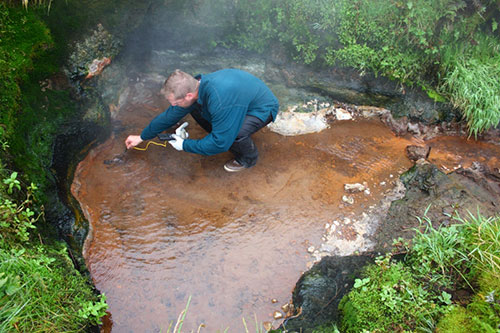
Geothermal Power Sources in Alaska’s Aleutian Islands Being Researched
February 25, 2015
Western Washington University assistant professor of Geology Pete Stelling is researching how to turn the island’s volcanic core into a geothermal power source that could not only cut the needed amount of imported fuel into a fraction of its current level but transform the quality of life for its inhabitants.
WWU Geologist Pete Stelling Researching Geothermal Power Sources in Alaska’s Aleutian Islands
“The majority of electrical generation today surrounds boiling water and using the steam to drive a turbine, which spins a generator and makes electricity. The fuel – coal, oil, or natural gas, for instance – is used to boil that water,” he said. “Geothermal sources skip the need for a fuel and go to the superheated water right at its source to make the electricity, and this could happen at places like Akutan to make them far more energy independent.” The perfect geothermal source, according to Stelling, occurs when the superheated water, over time, dissolves the surrounding rock and turns it into clay that acts as a cap, keeping the water and steam from escaping or losing pressure. Iceland, for example, is rife with these types of sources, one reason why the island nation is 80 percent powered by geothermal energy. Stelling is researching the viability of secondary sources that are far more common but less attractive for development. In most cases, these “second tier” geothermal sources were once under a glacier; the immense pressure of the glacier’s weight has pushed the hot water far closer to the surface, in most cases eroding the clay cap that has kept it under such high pressure. “The low-hanging fruit has very often been picked,” he said. “But these sources could be incredibly important, because they are far more numerous. What we are looking to find is just how powerful these secondary sources can be.” On Akutan, for example, harnessing the geothermal power from the sites that Stelling has researched could provide electricity to light and power the appliances in every home on the island as well as support its major industry, a seafood-processing plant that has up to 900 employees during peak season. In addition, the heat from the geothermal sources could provide ample warm air to operate greenhouses, allowing islanders to grow fruits and vegetables year-round – providing a scare commodity in a place that that sits at the end of a two-week ferry run from the mainland, as well as local jobs. Stelling’s chief task is working to understand just how efficient these secondary geothermal sources are; once he has established that baseline, the public and private sectors will have enough data to move forward with harnessing the resource for the benefit of the island’s population in a way that is far more economically viable and far less environmentally damaging than the current diesel-based methods, which currently comes all the way from Tacoma, Washington. Stelling will return to the island this summer to continue his work; he plans for his next research locations to be in similarly volcanic areas such as Chile and Colombia. “These secondary geothermal sites have such incredible potential,” Stelling said. “The more we learn about them, the more they can be used to improve the lives of these folks and make them more energy independent.”
Edited by Mary Kauffman, SitNews
Source of News:
|
||
